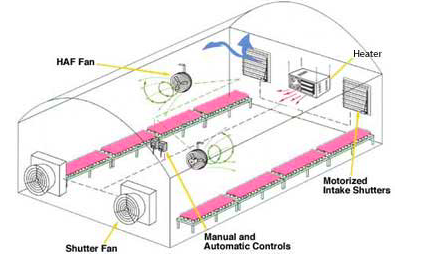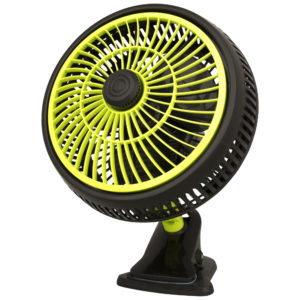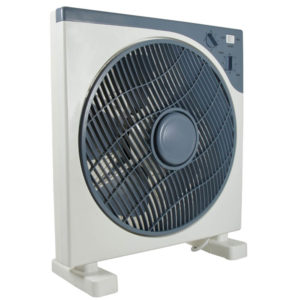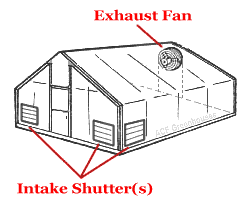Greenhouses are great at protecting our plants from the cold, however, they are more vulnerable to overheating and other issues related to bad airflow. Fortunately, greenhouse ventilation can alleviate these problems.
Proper air circulation not only controls temperatures, but also atmospheric humidity, CO2/oxygen supply, pathogens, etc. Not to mention that it combats the hot and stuffy air or bad smells that can make greenhouses an unpleasant place for gardeners.
There are various methods that can be applied to greenhouses, plastic greenhouses, and conservatories, or even garden shed ventilation and other broader uses. Read below to learn how to use them to provide favourable growing conditions for your plants throughout the year.
Does a greenhouse need ventilation?
Ventilation is important in ensuring that a greenhouse functions correctly, regardless of its size. Airflow contributes to the optimal growing conditions in the following ways:
Temperature
Typically, prolonged temperatures above 27°C pose a risk to plant leaves and overall plant health. In warmer months, from spring to autumn, ventilation helps to avoid excessive heat. A maximum-minimum thermometer can help you monitor temperatures.
Humidity
Plants transpire moisture that increases air humidity. If it’s not removed, it can cause mould, condensation, etc. in your greenhouse. The opposite can also occur in hot weather: low atmospheric humidity can exacerbate the heat damage done to plants and their leaves.
CO2/oxygen supply
Since plants need a good balance between CO2 and oxygen to photosynthesize, it’s important to supply fresh air. Otherwise, the air in the greenhouse may become oversaturated with one or the other.
Prevention of pests and diseases
Fungal diseases, such as powdery mildew, thrive in hot, humid conditions with little airflow. The same goes for certain pests such as aphids, gnats, shore flies, slugs, and snails.
Pollination
Some plant species (e.g., tomatoes, eggplants, and peppers) rely on wind to spread their pollen. Ventilation helps the release and movement of pollen.
Strength
Exposure to wind (or simulated wind) helps strengthen plant stems and root systems, creating sturdier and healthier plants. Even on a cellular level, it strengthens cell walls and improves transpiration.
Types of greenhouse ventilation
Ventilation can be provided in several ways. In essence, it needs to draw fresh air in and expel hot and humid air out.
Natural ventilation promotes the natural flow of air thanks to vents, curtains, and doors. It tends to be cost-efficient, saving up on electricity bills due to the lack of mechanical equipment. Vents and curtains can be fitted with solar controllers to govern operating times.
Mechanical ventilation uses fans. They come with various settings for precise control and maintain ideal greenhouse conditions regardless of climate, location, etc. Their features include oscillation, speed control, rotation, and more, and they can be attached to a thermostat.
How much ventilation does a greenhouse need?
When planning your ventilation, you need to calculate your needs based on things like the floor area of your greenhouse, air volume, etc.
One approach is to only use vents to create a passive system. Sidewall or base vents will draw in the fresh air, while hot air will rise and escape through vents positioned near the ceiling or on the roof (a.k.a. ridge vents) as seen in the greenhouse ventilation diagram below. This method is most effective in tall structures (especially above 3.5m).
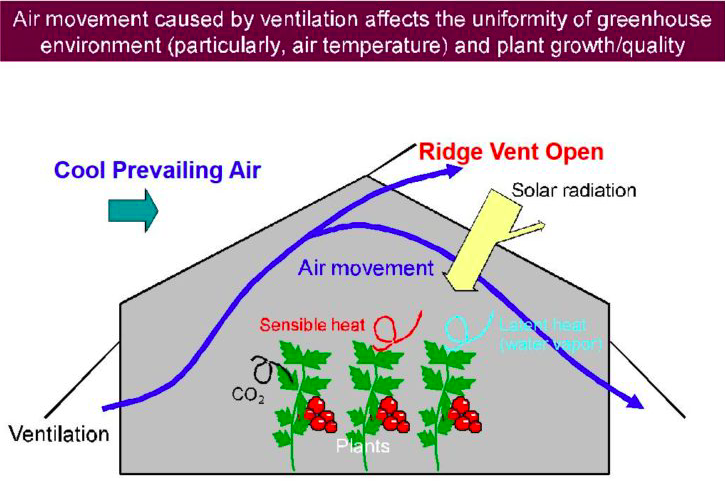
A good rule of thumb is to have your combined vent area (ridge and sidewall) equal 20% of the floor area. In other words, for 50 square metres of floor area, you should aim to have 10 square metres of ventilation, i.e. a 5:1 ratio.
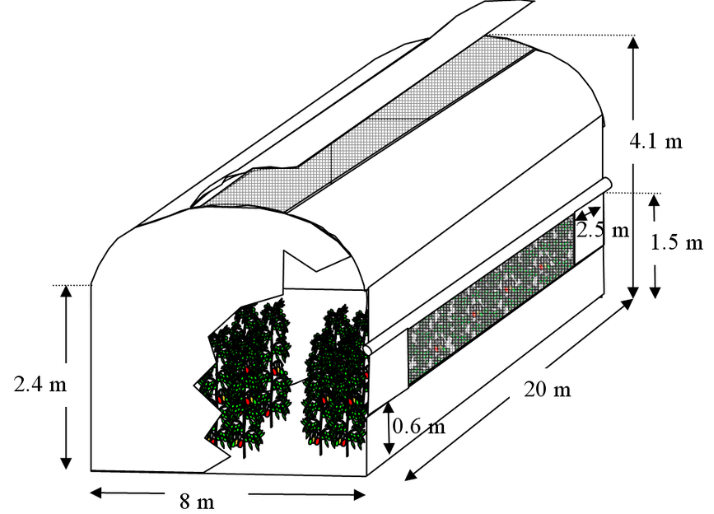
Another approach is to also include fans, which is particularly beneficial if you use your greenhouse in warmer months.
There are different types of fans, such as exhaust or extraction fans and circulation fans. Based on their diameter and speed, different models can move different amounts of cubic feet of air per minute (CFM).
Extraction fans are useful in the summer when more air circulation is needed. The sizing of fans depends on the air volume that they will need to move. To calculate (or estimate) that, multiply the Length x Width x Height of your greenhouse. One that is 3 meters wide x 6 meters long, with a 2.5-metre ceiling, has a volume of 3 x 6 x 2.5 = 45 cubic metres. Keep this volume in mind when deciding on fan capacity.
In the summer, you should aim for one air change per minute on average, or about 40-60 air changes per hour. Therefore, for 45 m3, your fan or fans should have a capacity of 45m3 per minute (CFM) or 2700m3 per hour.
Circulation fans can be used in passively ventilated structures (those without extraction fans) to assist air movement. Aim for a circular air pattern by directing fans in different directions. There are hanging, wall-mounted, or floor fans. A good rule of thumb is to have your total recirculating CFM equal 2 times the area of your greenhouse. For a greenhouse that’s 3 meters wide x 6 meters long, that means 3x6x2 = 36 CFM. For vertical gardening, you may need additional fans to improve the ventilation in the upper part of the greenhouse.
Note: If you’re only planning to use your greenhouse in the winter, this reduces your ventilation system needs. Read further below for more info.
Greenhouse ventilation ideas
As mentioned above, placing vents such as louvre vents closer to the ground will enable air intake. In smaller greenhouses, these can be installed on a DIY basis. Roof vents (ideally automated) or ridge vents will extract the hot and humid air.
Greenhouse ventilation fans will further boost the circulation of air. Extraction fans are installed close to the roof in order to extract hot air. It’s best to pull the air through the full length of the structure to avoid hot air pockets remaining. Oscillating circulation fans are great for creating uniform conditions across the entire greenhouse. Many smaller ones are better for circulation than fewer large ones. Clip fans are light and versatile, and can be fixed to horizontal and vertical poles. Wall-mounted fans also save space and provide lots of flexibility in terms of placement. Floor fans are portable and don’t require any installation.
Tip: Shading can help further reduce temperatures and is generally needed from mid-spring until early autumn. Since it can limit light, it should only be used to an extent.
Types of shading include:
- External blinds: maximum cooling effect as the sun’s rays cannot pass through the glass. Can be drawn up when needed, but may interfere with vents).
- Internal blinds: not as effective as external blinds since sunlight passes through the glass, but more affordable.
- Shade netting: can be fitted inside or outside the greenhouse. It degrades after several seasons but is not expensive to replace.
- Shading paints: painted onto the outside of the glass in spring and brushed off in early autumn. May leave traces on surfaces such as acrylic or polycarbonate.
How to ventilate a greenhouse in winter?
While summer ventilation has a lot to do with removing excess heat, winter ventilation is more about humidity control. The large temperature difference between the inside and outside of a greenhouse in winter causes condensation, which increases humidity levels.
In the winter months, air circulation needs decrease significantly compared to summer. However, they must not be ignored. You should aim for a rate of air circulation of about two-three air changes per hour. That way, you control humidity without allowing too much heat to escape.
Other useful tips for greenhouse ventilation in winter include:
- Circulation fans will help you keep the temperature consistent by mixing cold and hot air.
- Open greenhouse vents on warm sunny days and close them before dusk.
- Use a heating system – this could be either electric heating (which doesn’t emit moisture) or fan heaters. However, to avoid wasting energy, maintain the minimum temperature that’s safe for your plants. For a frost-free greenhouse, 3C is sufficient. Note that some plants prefer 7C or even 10C. Using a thermostat further helps reduce energy consumption and costs.
Greenhouse ventilation has a number of different nuances to it. However, as you can see, it can always be adjusted depending on the size and requirements of your particular space, as well as your budget. With the guidelines above, your greenhouse will have good ventilation year-round to keep your crops healthy and happy.


